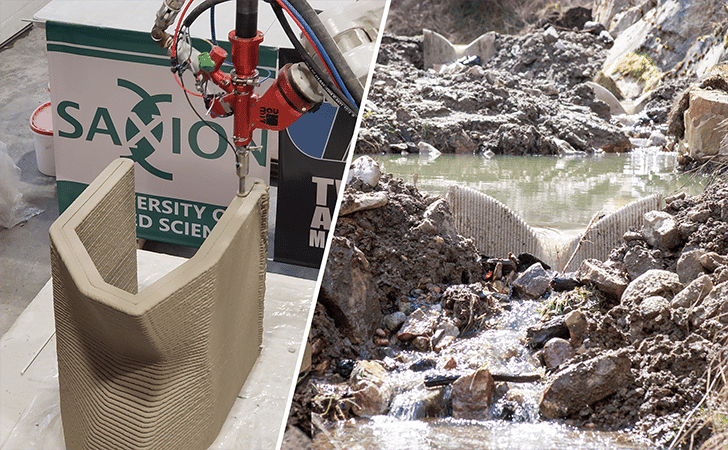3D concrete printing
New materials and technologies are becoming accessible at a rapid pace. But how does one develop innovative products with them? At Saxion Research Group Industrial Design we aim at bridging emerging developments with current industries via applied (design) research.
In this article you can find a short introduction to Additive Manufacturing of Concrete, the approach we have to it, and the challenges in front of its adaptation in the industry. Below you can read more about several completed projects and our on the on-going research topics.
Additive Manufacturing of Concrete
Additive Manufacturing changed the game in product design by offering an alternative to complex molds and mass production. You have probably already encountered articles about the 3D printed topology optimized parts from the automobile industry, seen videos about customized prosthesis, or even have shoe soles made specifically for your feet.
But how does the picture look like when it comes to 3D printing large-scale object?
The most used material in construction is also not new to the world of Additive Manufacturing. 3D Concrete Printing (3DCP) is a technology that gathered significant popularity in the last 10 years. Many see the potential of it as it essentially could eliminate the need for expensive single-use molds, especially in the prefab industry. 3DCP is a relatively fast process as the layer height and width could be up to several centimeters resulting in 2 – 60 l/min material deposition.
Currently, the global focus is at 3D printing of housing, with projects ranging from a tiny house to multistory buildings. While housing is certainly interesting, we find the form freedom, that the technology allows, much more suitable for product scale objects.
3DCP in product design
At Saxion Research Group Industrial design we have been involved in concrete additive manufacturing since 2014. Throughout the years, we have worked with companies within the domains of civil engineering, construction, logistics, raw materials, architecture, and design. Together with our business partners, we approach every (gradually increasing in complexity) research question by firstly trying to get a good insight into the current ways of working and the visions for the future. When transitioning from traditional methods into new, automated, and highly customized solutions, it often comes down to the change of approach: from “what is safe and easy to make” to “what is an optimal solution” or even “what is an aesthetically desirable solution”.
Combining design and production strategies for mass customization
Parametric design is when an object form is not set by sketches from the designer but by parameters(rules) that define its functions and shape. Such parameters can be the customer’s choice, material properties, surrounding constraints, etc. With such set-up, we translate complex yet flexible design rules into printable geometries. Implementing Rhino3D+Grasshopper software in the workflow also allows us to explore many options quickly as well as compare their performance, printability, and appearance in real time. While this sounds quite attractive, the reality is that it takes time for the industry to realize the potential of the methods.
Go beyond the lab
Getting out of the lab is essential to push innovation forward, make it visible and build trust. While it is essential to conduct the fundamental r esearch needed properly, it is also very important to find suitable showcase projects which can exhibit the strengths of the technique in a safe and attractive manner.
Our first completed project is the Green Façade made in collaboration with De Witte van der Heijden Architecten, Vertico Large Scale 3D printing, and Trebbe. The façade showcased the ability to produce a structure of all unique elements with dimensions finalized a day before the production.
Using the same design language we took the idea a step further in the project Green Dome. In there we achieved a double-curved form again with all unique elements. The structure is aimed at sheltering a composting unit as a part of the project Green Dome with Twente Milieu and TWW. Such examples not only help as proof of concept but also give insight on the handling, transportation and assembly process.
While these two examples give a good insight into the possible manufacturing possibilities of 3DCP, we stay interested in what are the attractive applications from a business perspective. Such are the two cases currently in development:
1. SPIRAL STAIRCASE

2. FISH LADDER

Selection Method
Working with these different applications has left us with an ever-increasing insight into finding proper applications. Based on this insight we are developing a selection method which will answer a central question for SME: “Is 3D concrete printing something for my company?”.
During three sessions the SME’s values are determined and connected to the possibilities of 3DCP. By doing so in a systematic way (or methodology), application ideas are formulated that not only fit 3DCP but also make sense from a business perspective.
Because the current method is at an advanced development stage, we are actually looking for companies who would like to validate the methodology with us.
In this way we hope we can contribute since it is crucial to facilitate a healthy transformation of enthusiasm from the new technology into real-life solutions relevant for the industry of today and tomorrow. The methodology can hopefully help companies identify new products, product features and markets which 3DCP can unlock or significantly improve. Moving from technology push to technology pull, we believe that the applications should lead the future developments of the technology so we can witness more sensible, durable and better performing concrete prints globally.